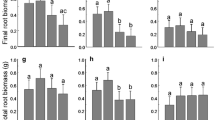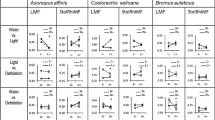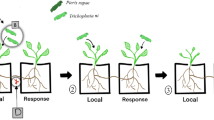Abstract
Meristem allocation models suggest that the patterns of compensatory regrowth responses following grazing vary, depending on (i) the number of latent meristems that escape from being damaged, and (ii) the activation sensitivity of the meristems in relation to the degree of damage. We examined the shape of compensatory responses in two late-flowering populations (59°20′N and 65°45′N) of the field gentian. Plants of equal initial sizes were randomly assigned to four treatment groups with 0, 10, 50 and 75% removal of the main stalk. The plants were clipped before flowering, and their performance was studied at the end of the growing season. The northern population showed a linear decrease in shoot biomass and fecundity with increasing biomass removal, while the response in the southern population was quadratic with maximum performance at the damage level of 50% clipping. This nonlinear shape depended upon the activation sensitivity of dormant meristems in relation to their position along the main stem. The highest plant performance was achieved by inflicting intermediate damage which induced regrowth from basally located meristems. In contrast, the topmost branches took over the dominance role of the main stem after minor apical damage (10% clipping). Consequently, the breakage of apical dominance is a necessary precondition of vigorous regrowth in this species. However, compensation in the field gentian is unlikely to be a mere incidental by-product of apical dominance. The ability to regrow from basally located meristems that escape from being damaged by grazing may well be a sign of adaptation to moderate levels of shoot damage.
Similar content being viewed by others
References
Aarssen, L.W. (1995) Hypotheses for the evolution of apical dominance in plants: implications for the interpretation of overcompensation. Oikos 74, 149-256.
Aarssen, L.W. and Irwin, D.L. (1991) What selection: herbivory or competition. Oikos 60, 261-262.
Alward, R.D. and Joern, A. (1993) Plasticity and overcompensation in grass responses to herbivory. Oecologia 95, 358-364.
Aronsson, M., Hallinbäck, T. and Mattsson, J-E. (1995) Rödlistade växter i Sverige 1995. Art-Databanken, Uppsala.
Belsky, A.J. (1986) Does herbivory benefit plants? A review of the evidence. Am. Nat. 127, 870-892.
Benner, B.L. (1988) Effects of apex removal and nutrient supplementation on branching and seed production in Thlaspi arvense (Brassicaceae). Amer. J. Bot. 75, 645-651.
Bergelson, J. and Crawley, M.J. (1992a) Herbivory and Ipomopsis aggregata the disadvantages of being eaten. Am. Nat. 139, 870-882.
Bergelson, J. and Crawley, M.J. (1992b) The effects of grazers on the performance of individuals and populations of scarlet gilia, Ipomopsis aggregata. Oecologia 90, 435-444.
Bergelson, J., Juenger, T. and Crawley, M.J. (1996) Regrowth following herbivory in Ipomopsis aggregata: compensation but not overcompensation. Am. Nat. 148, 744-755.
Bryant, J.P., Chapin, F.S. and Klein, D.R. (1983) Carbon/nutrient balance of boreal plants in relation to vertebrate herbivory. Oikos 40, 357-368.
Conover, W.J. and Iman, R.L. (1982) Analysis of covariance using the rank transformation. Biometrics 38, 715-724.
Crawley, M.J. (1997) Life history and environment. In M.J. Crawley (ed.) Plant Ecology. Blackwell Science, Oxford, pp. 73-131.
Escarré, J., Lepart, J. and Sentuc, J.J. (1996) Effects of simulated herbivory in three old field compositae with different inflorescence architectures. Oecologia 105, 501-508.
Geber, M.A. (1990) The cost of meristem limitation in Polygonum arenastrum: negative genetic correlations between fecundity and growth. Evolution 44, 799-819.
Georgiadis, N.J., Ruess, R.W., McNaughton, S.J. and Western, D. (1989) Ecological conditions that determine when grazing stimulates grass production. Oecologia 81, 316-322.
Hallé, F. (1986) Modular growth in seed plants. Philos. Trans. R. Soc. Lond. B 313, 77-87.
Hämet-Ahti, L., Suominen, J., Ulvinen, T. and Uotila, P. (eds) (1998) Retkeilykasvio (Field Flora of Finland). Finnish Museum of Natural History, Botanical Museum, Helsinki.
Hendrix, S.D. and Trapp, E.J. (1989) Floral herbivory in Pastinaca sativa: do compensatory responses offset reductions in fitness. Evolution 43, 891-895.
Huhta, A-P. and Rautio, P. (1998) Evaluating the impacts of mowing: a case study comparing managed and abandoned meadow patches. Ann. Bot. Fenn. 35, 85-99.
Huhta, A-P., Tuomi, J. and Rautio, P. (2000) Cost of apical dominance in two monocarpic herbs, Erysimum strictum and Rhinanthus minor. Can. J. Bot., 78, 591-599.
Hultén, E. and Fries, M. (1986) Atlas of North European Vascular Plants, North of the Trophic of Cancer. Koeltz Scientific Books, Königstein.
Irwin, D.L. and Aarssen, L.W. (1996) Testing the cost of apical dominance in vegetation: a field study of three species. Ann. Bot. Fenn. 33, 123-128.
Järemo, J., Nilsson, P. and Tuomi, J. (1996) Plant compensatory growth: herbivory or competition? Oikos 77, 238-247.
Juenger, T. and Bergelson, J. (1997) Pollen and resource limitation of compensation to herbivory in scarlet gilia, Ipomopsis aggregata. Ecology 78, 1684-1695.
Juenger, T. and Bergelson, J. (2000) The evolution of compensation to herbivory in scarlet gilia, Ipomopsis aggregata; herbivore-imposed natural selection and the quantitative genetics of tolerance. Evolution 54, 764-777.
Juenger, T., Lennartsson, T. and Tuomi, J. (2000). The evolution of tolerance to damage in Gentianella campestris: natural selection and the quantitative genetics of tolerance. Evol. Ecol. 14, 393-419 (this issue).
Karban, R. and Baldwin, I.T. (1997) Induced Responses to Herbivory. University of Chicago Press, Chicago.
Kelly, D. (1989) Demography of short-lived plants in chalk grassland. I. Life-cycle variation in annuals and strict biennials. J. Ecol. 77, 747-769.
Lehtilä, K. (1999) Impact of herbivore tolerance and resistance on plant life histories. In T. Vuorisalo and P. Mutikainen, (eds) Life History Evolution in Plants. Kluwer Academic Publishers, Dordrecht, pp. 303-328.
Lehtilä, K. and Syrjänen, K. (1995) Compensatory responses of two Melampyrum species after damage. Funct. Ecol. 9, 511-517.
Lennartsson, T. and Svensson, R. (1996) Patterns in the decline of three species of Gentianella in Sweden illustrating the deteoriation of semi-natural grasslands. Symb. Bot. Upsal. 31, 169-184.
Lennartsson, T., Tuomi, J. and Nilsson, P. (1997) Evidence for the evolutionary history of over-compensation in the grassland biennial Gentianella campestris (Gentianaceae). Am. Nat. 149, 1147-1155.
Lennartsson, T., Nilsson, P. and Tuomi, J. (1998) Induction of overcompensation in the field gentian, Gentianella campestris. Ecology 79, 1061-1072.
Lennartsson, T., Oostermeijer, G.B., van Dijk, J. and Nijs, H.C.M. (2000) Ecological significance of floral reproductive traits in Gentianella campestris (Gentianaceae). Basic and Applied Ecology 1, 69-81.
Mabry, C.M. and Wayne, P.W. (1997) Defoliation of the annual herb Abutilon theophrasti: mechanisms underlying reproductive compensation. Oecologia 111, 225-232.
Maschinski, J. and Whitham, T.G. (1989) The continuum of plant responses to herbivory: the influence of plant association, nutrient availability and timing. Am. Nat. 134, 1-19.
McNaughton, S.J. (1979) Grazing as an optimization process: grass-ungulate relationships in the Serengeti. Am. Nat. 113, 691-703.
McNaughton, S.J. (1983) Compensatory plant growth as a response to herbivory. Oikos 40, 329-336.
Montgomery, D.C. (1984) Design and Analysis of Experiments. 2nd edn. John Wiley and Sons, New York.
Moorby, J. and Wareing, P.F. (1963) Ageing in woody plants. Annals of Botany 27, 293-309.
Nilsson, P., Tuomi, J. and Åström, M. (1996a) Bud dormancy as a bet-hedging strategy. Am. Nat. 147, 269-281.
Nilsson, P., Tuomi, J. and Åström, M. (1996b) Even repeated grazing may select for overcompensation. Ecology 77, 1942-1946.
Oesterheld, M. (1992) Effect of defoliation intensity on aboveground and belowground relative growth rates. Oecologia 92, 313-316.
Oesterheld, M. and McNaughton, S.J. (1988) Intraspecific variation in the response of Themeda triandra to defoliation: the effect of time of recovery and growth rates on compensatory growth. Oecologia 77, 181-186.
Owen, D. and Wiegert, R.G. (1981) Mutualism between grasses and grazers: an evolutionary hypothesis. Oikos 36, 376-378.
Påhlsson, L. (ed.) (1994) Öppen brukningsbetingad vegetation. In Vegetationstyper i Norden. TemaNord 1994: 665. Nordiska ministerrådet, Köpenhamn, pp. 381-457.
Paige, K.N. (1992) Overcompensation in response to mammalian herbivory: from mutualistic to antagonistic interactions. Ecology 73, 2076-2085.
Paige, K.N. (1994) Herbivory and Ipomopsis aggregata: differences in response, differences in experimental protocol: a reply to Bergelson and Crawley. Am. Nat. 143, 739-749.
Paige, K.N. (1999) Regrowth following ungulate herbivory in Ipomopsis aggregata: geographic evidence for overcompensation. Oecologia 118, 316-323.
Paige, K.N. and Whitham, T.G. (1987) Overcompensation in response to mammalian herbivory: the advantage of being eaten. Am. Nat. 129, 407-416.
Preston, K.A. (1998) Architectural constraints on flower number in a photoperiodic annual. Oikos 81, 279-288.
Prins, A.H., Verkaar, H.J. and Van Den Herik, M. (1989) Responses of Cynoglossum officinale L. and Senecio jacobaea to various degrees of defoliation. New Phytologist 111, 725-731.
Rassi, P., Kaipiainen, H., Mannerkoski, I. and Ståhls, G. (1991) Uhanalaisten kasvien ja eläinten seurantakomitean mietintö (Report on the monitoring of threatened animals and plants in Finland). Committee Report 1991: 30, Min. Env., Helsinki.
Reichman, O.J. and Smith, S.C. (1991) Responses to simulated leaf and root herbivory by a biennial Tragopogon dubius. Ecology 72, 116-124.
Sachs, T. 1999. Node counting: an internal control of balanced vegetative and reproductive development. Plant, Cell and Environment 22, 757-766.
Saville, D.J. (1990) Multiple comparison procedures: the practical solution. The American Statistician 44, 174-180.
Sokal, R.R. and Rolf, F.J. (1995) Biometry. 3rd edn. W.H. Freeman and Company, New York.
Stephenson, W.R. and Jacobson, D. (1988) A comparison of nonparametric analysis of covariance techniques. Communications in Statistics, Simulation and Computation 17, 451-461.
Suzuki, T. (1990) Apical control of lateral bud development and shoot growth in mulberry (Morus alba). Physiol. Plant. 80, 350-356.
Tollrian, R. and Harvell, C.R. (1999) The Ecology and Evolution of Inducible Defences. Princeton University Press, Princeton, New Jersey.
Tuomi, J., Nilsson, P. and Åström, M. (1994) Plant compensatory responses: bud dormancy as an adaptation to herbivory. Ecology 75, 1429-1436.
Venecz, J.I. and Aarssen, L.W. (1998) Effects of shoot apex removal in Lythrum salicaria (Lythraceae): assessing the costs of reproduction and apical dominance. Ann. Bot. Fenn. 35, 101-111.
Verkaar, H.J., van der Meijden, E. and Breebart, L. (1986) The responses of Cynoglossum officinale L. and Verbascum thapsus L. New Phytologist 104, 121-129.
Wegener, C. and Odasz, A.M. (1997) Effects of laboratory simulated grazing on biomass of the perennial Arctic grass Dupontia fisheri from Svalbard: evidence of overcompensation. Oikos 79, 496-502.
Whitham, T.G., Maschinski, J., Larson, K.C. and Paige K.N. (1991) Plant responses to herbivory: the continuum from negative to positive and the underlying physiological mechanisms. In P.W. Price, T.W. Lewinsohn, G.W. Fernandes and W.W. Benson, (eds) Plant-Animal Interactions: Evolutionary Ecology in Tropical and Temperate Regions. John Wiley and Sons, New York, pp. 227-256.
Zar, J.H. (1996) Biostatistical Analysis. 3rd edn. Prentice Hall, Upper Saddle River, New Jersey.
Zieslin, N. and Halevy, A.H. (1976) Components of axillary bud inhibition in rose plants. 1. The effect of different plant parts (correlative inhibition). Bot. Gaz. 137, 291-296.
Author information
Authors and Affiliations
Rights and permissions
About this article
Cite this article
Huhta, AP., Lennartsson, T., Tuomi, J. et al. Tolerance of Gentianella campestris in relation to damage intensity: an interplay between apical dominance and herbivory. Evolutionary Ecology 14, 373–392 (2000). https://doi.org/10.1023/A:1011028722860
Issue Date:
DOI: https://doi.org/10.1023/A:1011028722860




